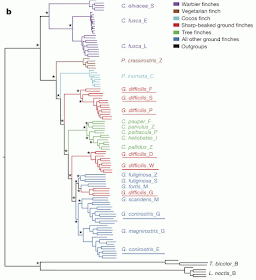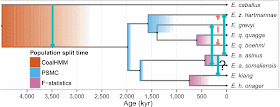Today is the third anniversary of starting this blog, and this is post number 325. Thanks to all of our visitors over the past three years — we hope that the next year will be as productive as this past one has been.
I have summarized here some of the accumulated data, in order to document at least some of the productivity.
As of this morning, there have been 238,613 pageviews, with a median of 192 per day. The blog has continued to grow in popularity, with a median of 70 pageviews per day in the first year, 189 per day in the second year, and 353 per day in the third year. The range of pageviews was 172-1148 per day during this past year. The daily pattern for the three years is shown in the first graph.
There are a few general patterns in the data, the most obvious one being the day of the week, as shown in the inset of the above graph. The posts have usually been on Mondays and Wednesdays, and these two days have had the greatest mean number of pageviews.
Some of the more obvious dips include times such as Christmas - New Year; and the biggest peaks are associated with mentions of particular blog posts on popular sites.
Unfortunately, the data are also seriously skewed by visits from troll sites. These have been particularly from the Ukraine, which is solely responsible for the peak between days 900 and 1000. The smaller following peak represents visits from Taiwan.
The posts themselves have varied greatly in popularity, as shown in the next graph. It is actually a bit tricky to assign pageviews to particular posts, because visits to the blog's homepage are not attributed by the counter to any specific post. Since the current two posts are the ones that appear on the homepage, these posts are under-counted until they move off the homepage, (after which they can be accessed only by a direct visit to their own pages, and thus always get counted). On average, 30% of the blog's pageviews are to the homepage, rather than to a specific post page, and so there is considerable under-counting.
 |
| Scatterplot of post pageviews through time, up to last week; the line is the median. Note the log scale, and that the values are under-counted (see the text). |
It is good to note that the most popular posts were scattered throughout the years. Keeping in mind the initial under-counting, the top collection of posts (with counted pageviews) have been:
| 129 42 172 10 181 73 58 188 146 98 49 29 8 |
The Music Genome Project is no such thing Charles Darwin's unpublished tree sketches The acoustics of the Sydney Opera House Why do we still use trees for the dog genealogy? How do we interpret a rooted haplotype network? Carnival of Evolution, Number 52 Who published the first phylogenetic tree? Phylogenetics with SpongeBob Charles Darwin's family pedigree network Faux phylogenies Evolutionary trees: old wine in new bottles? Network analysis of scotch whiskies Tattoo Monday |
8,347 5,271 5,052 3,954 3,644 2,398 2,077 2,037 2,011 1,951 1,870 1,756 1,747 |
The audience for the blog continues to be firmly in the USA. Based on the number of pageviews, the visitor data are:
| United States France Ukraine [spurious] Germany United Kingdom Russia Canada Australia China Turkey |
40.3% 6.8% 5.1% 5.0% 4.7% 3.1% 1.8% 1.6% 1.0% 0.7% |
Finally, if anyone wants to contribute, then we welcome guest bloggers. This is a good forum to try out all of your half-baked ideas, in order to get some feedback, as well as to raise issues that have not yet received any discussion in the literature. If nothing else, it is a good place to be dogmatic without interference from a referee!










